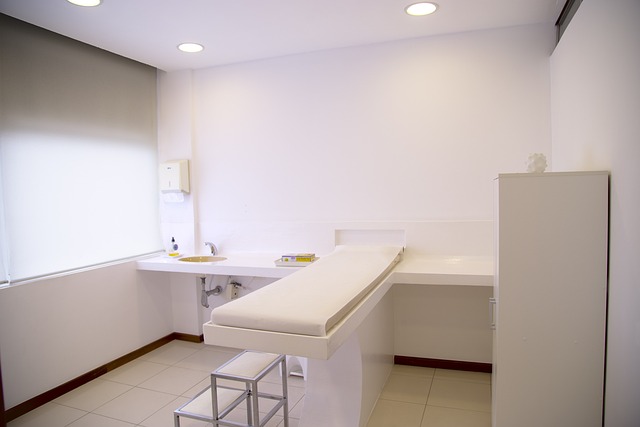Post-Traumatic Stress Disorder (PTSD) therapy focuses on cognitive-behavioral therapies (CBT), EMDR, CPT, exposure therapy, and group support. Holistic lifestyle changes include diet, exercise, sleep, and stress management. Medication, like SSRIs, assists in symptom regulation. Long-term management involves tailored psychotherapy, self-care, social support, and resilience-building strategies to ensure sustained healing.
“PTSD symptom management is a multifaceted journey towards healing. This article explores comprehensive therapies for navigating the complex landscape of Post-Traumatic Stress Disorder. From unraveling the disorder’s intricacies to implementing effective treatments, we delve into various techniques. Discover the power of Cognitive Behavioral Therapy (CBT), Exposure Therapy, and Eye Movement Desensitization (EMDR).
Learn about the supportive network of group therapy, alongside practical lifestyle changes and medication options. Understand long-term management strategies for sustained recovery. Explore these evidence-based PTSD treatment methods to reclaim your well-being.”
Understanding PTSD: Unraveling the Complex Disorder

Post-Traumatic Stress Disorder (PTSD) is a complex and multifaceted condition that arises from exposure to traumatic events. It’s more than just feeling scared or anxious; it’s a profound mental health disorder that can significantly impact an individual’s daily life and overall well-being. Understanding PTSD involves recognizing its various symptoms, which can manifest in different ways, such as intense flashbacks, nightmares, severe anxiety, avoidance behaviors, and heightened irritability.
The key to managing PTSD lies in effective therapy and treatment approaches. Through specialized therapies like cognitive-behavioral therapy (CBT), eye movement desensitization and reprocessing (EMDR), and trauma-focused support, individuals can learn coping mechanisms to navigate their symptoms. PTSD treatment aims to help patients process traumatic memories, develop healthy strategies for emotional regulation, and regain a sense of control over their lives. By addressing the root causes and providing the right tools, therapy offers hope and a path to healing for those struggling with this complex disorder.
Therapy Approaches: Effective Treatments for PTSD

Effective PTSD treatment often involves therapy approaches tailored to address the unique symptoms and experiences of each individual. One prominent and well-researched method is Cognitive Processing Therapy (CPT), which helps individuals identify and challenge negative thoughts and beliefs related to their traumatic event(s). This approach encourages a more balanced perspective, reducing the power these memories hold over their lives.
Another evidence-based treatment is Eye Movement Desensitization and Reprocessing (EMDR). EMDR combines exposure therapy with guided eye movements, helping individuals process traumatic memories in a safe manner. By triggering a natural healing response, EMDR can significantly reduce symptoms of PTSD, offering a promising path towards recovery and improved quality of life.
Cognitive Behavioral Therapy (CBT): A Step-by-Step Guide

Cognitive Behavioral Therapy (CBT) is a widely recognized and effective PTSD treatment approach. This therapy focuses on challenging and modifying negative thought patterns and behaviors that contribute to PTSD symptoms. Here’s a step-by-step guide to understanding CBT for managing PTSD:
1. Identifying Negative Thought Patterns: The first step involves becoming aware of distorted or unhelpful thoughts that arise in response to traumatic memories or triggers. These thoughts can be irrational, exaggerated, or unrealistic. By recognizing these patterns, individuals start to question their validity.
2. Challenging and Reframing Thoughts: Once identified, CBT encourages patients to challenge these negative thoughts using logical reasoning and evidence. It involves questioning the accuracy of these thoughts and replacing them with more balanced and realistic alternatives. This process helps shift one’s perspective, reducing emotional distress associated with PTSD.
3. Exposure Therapy: A key component of CBT for PTSD is exposure therapy, where individuals gradually face their fears in a safe, controlled environment. This can involve recalling traumatic memories or exposing oneself to situations that evoke anxiety. Over time, this reduces the intensity of fear responses and helps individuals develop coping strategies.
4. Behavioral Activation: CBT also promotes behavioral activation, which encourages patients to participate in activities they once enjoyed but avoided due to PTSD symptoms. By engaging in meaningful activities, individuals can improve their mood, reduce symptoms of avoidance, and regain a sense of control over their lives.
Exposure Therapy: Facing Fears and Overcoming Trauma

Exposure therapy is a powerful technique within PTSD treatment, designed to help individuals confront and overcome traumatic memories or situations. By gradually and safely exposing themselves to the feared stimuli, patients can learn to manage their reactions and reduce the intensity of symptoms associated with trauma. This process starts with identifying specific triggers that evoke PTSD symptoms, often through memory recall or realistic simulations. As therapy progresses, individuals are encouraged to face these fears in a controlled environment, allowing them to develop coping strategies and regain a sense of control.
Through repeated exposure, patients can desensitize themselves to traumatic memories, reducing the powerful emotional responses that characterize PTSD. This method empowers individuals to take back power over their lives, enabling them to navigate through triggering situations without being overwhelmed. Effective exposure therapy not only offers relief from symptoms but also promotes healing and personal growth in managing their traumatic experiences.
Eye Movement Desensitization and Reprocessing (EMDR)

Eye Movement Desensitization and Reprocessing (EMDR) is a specialized therapy approach recognized as an effective PTSD treatment. This method helps individuals process traumatic memories by encouraging them to recall and re-experience these events while simultaneously engaging in bilateral stimulation, typically through side-to-side eye movements or other sensory inputs like taps or tones. This unique combination facilitates the brain’s natural healing process, allowing stored memories to be reprocessed and reduced in intensity.
EMDR therapy offers a structured framework that assists patients in reframing their traumatic experiences from distressing to manageable. By desensitizing individuals to the disturbing aspects of their memories, EMDR enables them to gain new perspectives, reduce symptoms of avoidance, and enhance emotional regulation. This non-invasive technique has gained significant recognition in the field of mental health as a valuable tool for PTSD treatment, providing hope and improved quality of life for those struggling with traumatic memories.
Group Therapy: Healing in a Supportive Community

Group therapy offers a powerful and unique approach to PTSD symptom management, providing individuals with a supportive community to navigate their healing journey. In this therapeutic setting, people struggling with post-traumatic stress disorder (PTSD) can connect with others who share similar experiences, fostering a sense of belonging and understanding. This shared environment encourages open communication, allowing participants to express their feelings, fears, and strengths in a safe and non-judgmental space.
Through group therapy sessions, individuals learn valuable coping strategies and gain insights from one another’s journeys. The collective energy within the group can be therapeutic, as members inspire and support each other through various activities and discussions. This type of therapy not only assists in managing PTSD symptoms but also promotes a sense of community, which is essential for long-term healing and resilience.
Lifestyle Changes: Nurturing Mind and Body for Recovery

For individuals seeking PTSD treatment, incorporating lifestyle changes that nurture both mind and body can significantly enhance recovery. This includes adopting a balanced diet rich in nutrients essential for brain health, as proper nutrition supports cognitive functions and emotional resilience. Regular physical activity is another crucial component; exercise releases endorphins, which can alleviate symptoms of anxiety and depression, common co-morbidities associated with PTSD.
Additionally, prioritizing sleep hygiene and stress management techniques such as mindfulness meditation or yoga can help regulate the nervous system. Engaging in activities that promote relaxation and self-care fosters a sense of safety and control, enabling individuals to better manage traumatic memories and triggers. Ultimately, these lifestyle adjustments create a supportive environment, facilitating the healing process in conjunction with professional PTSD treatment approaches.
Medication Options: Managing Symptoms Pharmaceutically

Medication options play a significant role in the management of Post-Traumatic Stress Disorder (PTSD) symptoms, offering a pharmacological approach to alleviate distress and improve quality of life. Selective Serotonin Reuptake Inhibitors (SSRIs) are commonly prescribed as they enhance serotonin levels in the brain, helping to regulate mood and reduce anxiety. These medications can assist individuals in coping with intrusive thoughts, flashbacks, and nightmares associated with PTSD.
Other classes of drugs, such as non-benzodeazepines and beta-blockers, may be utilized for specific symptoms like insomnia or hyperarousal. While these pharmaceutical interventions don’t cure PTSD, they provide valuable tools for symptom management, allowing individuals to gain more control over their lives and engage in other therapeutic processes, like therapy and lifestyle changes.
Long-Term Management: Sustaining Healing and Well-being

After initial PTSD therapy, long-term management is crucial for sustaining healing and well-being. This often involves ongoing psychotherapy sessions tailored to address persistent symptoms. Techniques like cognitive processing therapy (CPT) and eye movement desensitization and reprocessing (EMDR) can help individuals process traumatic memories effectively and reduce avoidance behaviors.
Incorporating self-care practices, such as regular exercise, mindfulness meditation, and a balanced diet, plays a vital role in long-term management. Additionally, social support from friends, family, or support groups can significantly enhance recovery by providing a sense of belonging and understanding. Ongoing care plans may also include stress management strategies, healthy coping mechanisms, and the development of resilience to better navigate future challenges.
